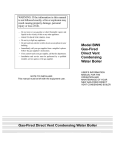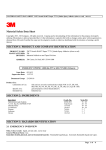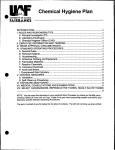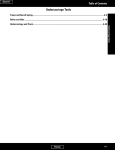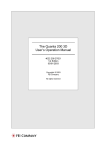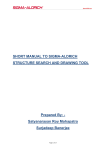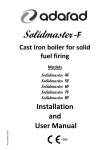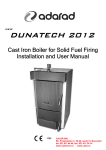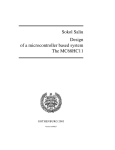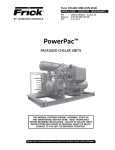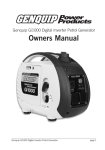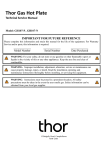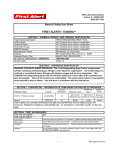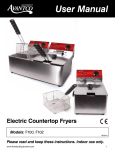Download USER MANUAL - System One - SystemOne Technologies Inc.
Transcript
RECYCLING GENERAL PARTS WASHERS 300 / 500 SERIES USER MANUAL Serial Number______________ DeliveryDate______________________ TABLE OF CONTENTS Page REGULATORY INFORMATION ------------------------------------------------------------------ 1 INTRODUCTION ---------------------------------------------------------------------------------- 2 ILLUSTRATIONS ---------------------------------------------------------------------------------- 3 OPERATING INSTRUCTIONS WASH --------------------------------------------------------------------------------------- 4 RECYCLE------------------------------------------------------------------------------------ 4 RESIDUE REMOVAL----------------------------------------------------------------------- 5 SPECIFICATIONS --------------------------------------------------------------------------------- 6 REGULATORY COMPLIANCE -------------------------------------------------------------------- 7 SAFE OPERATING INSTRUCTIONS ------------------------------------------------------------ 8 HEALTH AND SAFETY PRECAUTIONS --------------------------------------------------------- 9 FIRST AID INSTRUCTIONS ------------------------------------------------------------------- 10 ENVIRONMENTAL CARE ----------------------------------------------------------------------- 10 MATERIAL SAFETY DATA SHEETS ----------------------------------------------------------- 11 TROUBLESHOOTING --------------------------------------------------------------------------- 19 MANUFACTURERS WARRANTIES ------------------------------------------------------------ 20 REGULATORY INFORMATION ETL LISTED This unit has been tested and complies with UL 2208 - Standard for Solvent Distillation Units. It meets the requirements under OSHA 29CFR1910.303 and conforms to the relevant safety standards and the standards for hazardous location in which the unit is operating. CAUTION IMPORTANT INFORMATION: Install, operate, and maintain this equipment in accordance with the instruction manual to reduce the risk of fire or explosion. This unit is for use in an 102°F (39°C) environment without forced ventilation. Under these conditions, the unit shall be spaced a minimum 3 feet (1 meter) from potential sources of ignition such as electrical receptacles, switches, pilot lights, fixtures, contacts, and other similar equipment that can produce sparks. If the equipment is used in higher ambient temperatures, an increase in spacing to sources of ignition shall be considered. This unit has only been investigated for use with mineral spirits (aliphatic hydrocarbon). CAUTION MINERAL SPIRITS (Aliphatic Hydrocarbon) HARMFUL IF SWALLOWED OR INHALED, CAUSES IRRITATION. Keep away from heat, sparks, and flame. Avoid contact with eyes, skin and clothing. Avoid breathing vapor. Use with adequate ventilation. Wash thoroughly after handling. EFFECTS OF OVEREXPOSURE: Contact may be irritating to skin, eyes, nose and throat. Ingestion may cause nausea, vomiting, diarrhea, dizziness or unconsciousness. FIRST AID PROCEDURES: Get medical attention immediately. If inhaled, remove to fresh air. If not breathing, give artificial respiration. If breathing is difficult, give oxygen. In case of contact, gently flush eyes while holding eyelids apart. Wash exposed skin with soap and water. If swallowed do not induce vomiting, place person on left side with head down. In all cases contact a physician. CAUTION To reduce risk of electrical shock, connect only to a properly grounded, grounding-type receptacle. Unit should be installed on a dedicated 15 ampere branch circuit. WARNING WARNING HOT. Never drain during recycling process or when knob is hot to the touch. -1- INTRODUCTION SYSTEMOne® is a revolutionary new class of RECYCLING Parts Washers representing the most technologically advanced, efficient and environmentally safe parts washers available today. THE ADVANTAGES !"Provides clean crystal clear automatically in just 4 minutes. solvent "on demand" every day, !"Eliminates dependence on waste recovery services and typically avoids classification as a waste generator. !"Ensures practical and cost effective compliance with environmental regulations. !"Eliminates potential liabilities for improper handling, storage and transportation of waste materials. !"Provides substantial savings by significantly improving productivity. !"Redefines waste management standards by changing the focus from waste removal and recovery to waste minimization. PURE SOLVENT AT ALL TIMES SYSTEMOne® provides users with clean solvent everyday, and allows for the perpetual use and re-use of solvents by removing all contaminants from the solvent. SYSTEMOne® utilizes a patented low-temperature, vacuum distillation process to recycle the contaminated solvent within a totally enclosed self-contained unit. Pure solvent is always readily available to the customer "on demand" without the need to wait for periodic deliveries and hazardous waste disposal services. Focusing on waste minimization rather than removal and recovery, SYSTEMOne® provides dramatic advantages in the protection of our environment. -2- ILLUSTRATIONS Pneumatically Supported Lid (Model 500) Closes to minimize evaporation. Fusible link on all models. Spigot with cleaning brush* attachment. Directs mineral spirits for efficient parts cleaning. (*Optional on 300 series) Large Wash Area Recycle Button To distill wash basin contents and return fresh cleaning fluid. On/Off Button To start wash process and to bring additional fluid to wash area when needed. Discharge Knob For easy removal of residue. Standard Power Cord No pneumatics or special wiring required. Plug and go operation. ADDITIONAL FEATURES INCLUDE ETL (ANSI/UL 2208) LISTED Ergonomic Design for User Efficiency and Comfort Sturdy Metal Construction -3- OPERATING INSTRUCTIONS WASH Push On/Off Button to start or stop solvent flow through spigot and flow through brush. If solvent does not flow when the On/Off button is depressed, refer to the troubleshooting guide at the end of this manual. NOTE: Practice good housekeeping when washing parts and allow items to drain before removing them from the wash area. Removing solvent from the wash area may reduce cleaning efficiency and increase overall solvent usage. To keep solvent usage to a minimum, do not remove solvent for remote cleaning operations and close lid when not in use. IMPORTANT: Use only solvent provided or approved by SYSTEMOne®. DO NOT add chemicals, solvents or cleaning agents. The use of non-specified chemicals in the wash sink may result in contamination of the residue and subject the user to hazardous waste regulation and may void the manufacturer’s warranty. RECYCLE Push Recycle Button once to transfer dirty solvent into distillation and return clean fluid to the wash basin. Cleaning operations will be available in 4 minutes. If the clean fluid is not returned to the sink within 4 minutes, refer to the troubleshooting guide at the end of this manual. NOTE: During the recycle process, it is normal to hear the unit operate for several hours. It is completely automated and will turn itself off when finished. Do not unplug the unit during this process. If power is interrupted during the recycle process, the equipment should restart and finish automatically although process time may be extended. WARNING The discharge knob will be hot to the touch during the recycle process. Do not open or touch the discharge knob while the recycle process is operating or until the temperature indicator turns GREEN. -4- RESIDUE REMOVAL Wait until the system completes the recycling process, cools down and the temperature indicator turns green. Unscrew counter-clockwise and remove the Discharge Knob and allow the residue to drain into a container. NOTE: If you unscrew the Discharge Knob and the residue does not drain freely, it may be unusually thick from dirty or gritty cleaning operations. Insert a firm, flexible wire rod into the distillation drain opening to assist removal of residue. If problems persist, contact Service Support at 800-711-1414 NOTE: The amount of residue accumulation will vary with the usage of the machine. Under normal conditions, the residue should be drained on a weekly basis and should expect 2 to 3 quarts of fluid. If more fluid is removed, the frequency of draining intervals should be increased. If only small amounts of fluid is removed, you should decrease the frequency draining intervals to allow more residue to accumulate. WARNING The discharge knob will be hot to the touch during the recycle process. Do not open or touch the discharge knob until the temperature indicator turns GREEN and/or the knob is cool to the touch. -5- SPECIFICATIONS POWER 115 vac minimum / 60 hz / 3 prong grounded outlet. The unit should be installed on a dedicated 15 amperes branch circuit (20 amperes if shared with other devices). Electric consumption during wash operations: <1 amp. Electric consumption during recycle operations: No greater than 12 amps. NOTE: If multiple units are placed in older facilities, it is recommended to operate the recycle process at staggered intervals or a low electrical usage periods to avoid excessive electrical demand on the main service panel. SOLVENT Standard models use only 140°F flash mineral spirits (Aliphatic Hydrocarbon) with an upper limit boiling point no higher than 425°F. VOC exempt models use only solvent provided by or approved for use by SYSTEMOne®. NOTE: Solvent replenishment requirements range from 15 to 30 gallons per year per unit, depending on the application and useage. Solvent requirements over 30 gallons per year represents unusual usage. In cases where solvent usage exceeds 30 gallons per year, the customer should take action to determine the cause for loss. Typically, the solvent is being removed for remote cleaning operations and not replaced in a timely fashion. Management should take action to deter improper removal of solvent form the SYSTEMOne® parts washer. DIMENSIONS MODEL 300 FLOOR SPACE 27” x 32” WORKING HEIGHT 33” WEIGHT 480 lbs. full SINK CAPACITY 3 gallons RESERVOIR CAPACITY 19 gallons MODEL 500 30” x 39” 32” 552 lbs. full 5 gallons 29 gallons -6- MODEL 550 36” x 48” 32” 585 lbs. full 5 gallons 29 gallons MODEL 570 33” x 45” 32” 572 lbs. full 5 gallons 29 gallons REGULATORY COMPLIANCE 1. SYSTEMOne® is a totally enclosed treatment process that effectively separates mineral spirit solvents from oil and other impurities. The resultant residue may be managed as used oil and is exempt from hazardous waste disposal and recovery regulations. 2. The SYSTEMOne® distillation process separates mineral spirit solvents from oil and other impurities. It does not chemically change the resulting residue which can be managed as used oil per Federal regulations. Federal Regulation 40 CFR 279 Subpart B, paragraph (b)(2)(iii) documents that where a mixture of mineral spirits and used oil does not exhibit ignitable characteristics, the presence of mineral spirits does not preclude the treatment of the residue as used oil, even in circumstances with less than 100% percent effective separation. 3. SYSTEMOne®, properly utilized in accordance with the Manufacturer's user manual and specifications, generates no hazardous waste - only a small volume of oily residue. Small quantity waste generators whose sole source of hazardous waste is parts washers, upon conversion to SYSTEMOne® typically can avoid classification as a small quantity waste generator or be reclassified from small quantity generator to conditionally exempt (under 100 kilograms) small quantity generator (“CESQG”). Even in circumstances where the oily residue may be classified as a regulated hazardous waste, Federal Regulation 40 CFR 261.5(a) and 261.5 (g)(3) allows CESQG's to place their hazardous waste in used oil containers and the resulting mixture will be regulated as a used oil. IMPORTANT The customer is ultimately responsible for the proper handling of the residue by-product and proper use of SYSTEMOne® equipment in accordance with the manufacturer's User Manual and specifications. It is recommended that the residue be tested periodically to confirm that the equipment is being utilized properly and that the residue from your unit is properly managed as used oil. The manufacturer will be pleased to arrange for the testing at a nominal cost. -7- SAFE OPERATING INSTRUCTIONS 1. USE ONLY SOLVENTS PROVIDED OR APPROVED BY THE MANUFACTURER. DO NOT add other chemicals to the cleaning solvent, including but not limited to kerosene, fuel oil, gasoline, detergents, or chlorinated solvents. Adding chemicals may cause hazardous conditions over which the manufacturer and the manufacturer's agents have no control and no responsibility. 2. DIRECT FLOW OF SOLVENT INTO THE SINK. DO NOT use compressed air to agitate the solvent or dry parts. Drain clean parts in the machine until dripping ceases. DO NOT clean or degrease porous or absorbent materials. DO NOT use solvents on friction materials such as brake linings and clutch surfaces that are to be reused. Wipe rubber and metal brake parts completely dry before reassembly. 3. TURN THE MACHINE OFF WHEN ADDING SOLVENT. DO NOT add solvent during the recycling process. Regularly drain residue from drain spout. DO NOT drain residue when residue knob is hot after recycling, wait until the knob is cool to the touch. Periodically clean the removable sink strainer. Never operate machine without the strainer. 4. DO NOT MODIFY THE MACHINE IN ANY WAY. DO NOT obstruct or hang anything on the sink cover containing the fusible link. Obstructions prevent the cover from closing automatically in the event of fire. DO NOT replace the fusible link with any other device to hold lid up. If the fusible link should break, contact SYSTEMOne® Service Support immediately at 1-800-711-1414. 5. DO NOT OPERATE MACHINE UNATTENDED. Close the machine lid when not in use as a safety precaution (Series 500 only) and to minimize solvent evaporation. 6. DO NOT ATTEMPT TO REPAIR THE MACHINE YOURSELF. Tampering with or attempting to repair the machine may void the manufacturer’s warranty. If you follow all instructions and cannot correct a malfunction, call SYSTEMOne® Service Support at 1-800-711-1414 for assistance. SYSTEMOne® parts washers are warranted to be free of defects in materials and workmanship for three (3) years. An extended five (5) year warranty is available at a nominal charge (see “Exhibit 2 - Warranty”). -8- HEALTH AND SAFETY PRECAUTIONS 1. KEEP OUT OF REACH OF CHILDREN AT ALL TIMES. 2. COMBUSTIBLE LIQUID. Keep a minimum three (3) foot distance from heat, sparks, flame or other sources of ignition. DO NOT place hot parts in the machine. DO NOT spray aerosols into or around the machine. DO NOT use in enclosed areas. Use only with adequate ventilation to prevent vapor buildup. 3. SMOKING. DO NOT smoke within a minimum three (3) foot distance from the machine. 4. SOLVENT HARMFUL OR FATAL IF INGESTED (SWALLOWED). DO NOT eat or drink while operating the machine. Ingestion, intentional misuse or prolonged overexposure to solvents can cause neurological and other physiological damage and possible fatality. If ingested, follow first aid instructions below and seek immediate medical attention. 5. VAPOR INHALATION (BREATHING) HARMFUL. Inhalation of solvent vapor can cause nausea, vomiting, breathing difficulty, headaches, dizziness, cardiac, pulmonary or other central nervous system damage. Avoid prolonged breathing of vapors. Use only in well ventilated areas or with approved respirator. If strong odor is noticed or dizziness, headache, nausea or eye watering is experienced STOP- ventilation is inadequate. Turn off the machine and leave the work area. Intentional misuse can be fatal. 6. AVOID CONTACT WITH EYES. Eye contact with solvent or exposure to vapor may cause eye irritation, watering, stinging, or redness. Where there is likelihood of eye contact, wear chemical goggles or faceshield. DO NOT wear contact lenses without proper eye protection. 7. AVOID CONTACT WITH SKIN. Prolonged skin contact with solvent may cause irritation, redness, burning, drying, cracking or dermatitis. If prolonged skin contact is likely, wear protective gloves, clothing and shoes. If clothing is inadvertently sprayed with solvent, remove immediately to prevent skin rash or fire hazard. IMPORTANT See Material Safety Data Sheets (Exhibits 1-4) SYSTEMOne® emergency telephone number: -9- 1-800-535-5053 FIRST AID INSTRUCTIONS 1. EYES: Flush eyes with abundant water for 15 minutes. Consult physician immediately if irritation or pain persists. 2. SKIN: Remove contaminated clothing and shoes. Wash skin thoroughly with soap and water. Consult physician if irritation persists. 3. INHALATION (BREATHING): Move to fresh air immediately. If continued difficulty is experienced, seek immediate medical attention. 4. INGESTION (SWALLOWING): Seek immediate medical attention from poison control center, hospital emergency room or physician. DO NOT induce vomiting. If spontaneous vomiting occurs, keep head below hips to avoid aspiration into lungs. See Material Safety Data Sheets (Exhibits 1-4) SYSTEMOne® emergency telephone number: 1-800-535-5053 ENVIRONMENTAL CARE 1. Cleaning operations should be conducted in a manner that prevents spillage. Any spillage should be promptly cleaned up. 2. Stop leaks only when there is no risk or danger. Notify SYSTEMOne® Service Support at 1-800-711-1414 immediately. 3. Maintain proper housekeeping in the area of the parts cleaner at all times. 4. Use only solvents provided or approved by SYSTEMOne®. DO NOT add other chemicals, solvents or cleaning agents. The use of non-specified chemicals may result in the contamination of the residue and thereby subject the user to hazardous waste regulation. - 10 - MATERIAL SAFETY DATA SHEETS Qsol 100 Cold Cleaning Solvent HMIS HAZARD RATING 4=EXTREME 3=HIGH 2=MODERATE 1=SLIGHT 0=INSIGNIFICANT FIRE REACTIVE TOXICITY SPECIAL 2 0 1 0 SECTION 1 - PRODUCT INFORMATION Distributed by: SystemOne Technologies Inc., A Mansur Industries Company Date Revised: January 24, 2000 Address: 8305 NW 27th Street, Suite 107; Miami, FL 33122 Telephone No.: 1-305-593-8015 CAM Emergency No.: 1-800-535-5053 Trade Name: SystemOne QSOL 100 Parts Cleaner Product Type: Hydrotreated hydrocarbon PD-680 Type 2 SECTION 2 - HAZARDOUS INGREDIENTS CHEMICAL NAME/COMMON NAME Aliphatic Petroleum Distillates / Hydrotreated / CAS NO. PERCENT (optional) 64742-88-7 100 TLV PEL NE NE CEL N/A PD-680 Type 2 SECTION 3 - PHYSICAL DATA Boiling Point: 365-402F Specific Gravity: 0.79 pH: N/A Vapor Pressure (mmHg): ca. 0.5 Vapor Density (Air=1): ND Solubility in Water (% by weight): Virtually insoluble Percent Volatile (by wt.): 100% VOC (g/L by Wt): 0.790 kg/L Evaporation Rate (vs. H20 = 1.0): >1.0 Freezing Point: ND Appearance and Odor: Clear, colorless liquid with slight odor Odor Threshold: ND SECTION 4 - FIRE AND EXPLOSION HAZARD DATA Flash Pt. TCC: 143F Combustible Liquid: Yes Explosive Limits in Air: by % Volume / Upper: 7.0 Lower: 1.0 Extinguishing Media: Foam, dry chemical, carbon dioxide, water fog or spray. Drums heated by a fire can burst. Ground electrical equipment while handling. Fire Fighting Procedures: Evacuate all unnecessary personnel. Shut down motors, pumps, and electrical service. Use water spray to keep fire-exposed containers cool to avoid pressure buildup. Wear NIOSH/MSHA approved positive pressure self-contained breathing apparatus and full protective clothing. - 11 - SECTION 5 – REACTIVE DATA Stability: Stable Incompatibility: None known Reacts with: Avoid contact with Oxidizers Hazardous Decomposition Products: Oxides of carbon Hazardous Polymerization: Will not occur SECTION 6 - HEALTH HAZARDS May cause irritation by all routes of exposure. May produce symptoms of central nervous system depression including headache, dizziness, nausea, loss of balance and drowsiness. Signs and Symptoms of Over-exposure (Acute): May be irritating to eyes and skin. Defatting to skin on repeated contact. Signs and Symptoms of Over-exposure (Chronic): Prolonged or repeated breathing or swallowing of large amounts may cause liver damage. Ingestion may cause damage to the gastrointestinal tract. Medical Conditions Aggravated By Over-Exposure: Unknown SECTION 7 - EMERGENCY AND FIRST AID PROCEDURES Eyes: Immediately flush eyes with water for 15 minutes, holding eyelids open if necessary. Get medical attention if irritation persists. Skin: Wash thoroughly with soap and water. Wash clothing before reuse. Get medical attention if irritation occurs. Ingestion: Do not induce vomitting. This material is not soluble. Do not give fluids.Get medical attention immediately. Prevent aspiration if vomiting occurs. Inhalation: Remove to fresh air. If breathing is difficult have trained person administer oxygen. If respiration stops have a trained person administer artificial respiration. SECTION 8 - SPECIAL PROTECTION INFORMATION Respiratory Protection: No special requirements Ventilation Requirements: General Exhaust Protective Gloves: Chemical resistant protective gloves Eye Protection: Safety glasses Other Protective Clothing: Plastic or rubber apron SECTION 9 - SPILL OR LEAK PROCEDURES Wear chemical safety goggles plus full face shield, chemical resistant gloves, plastic/rubber apron. Evacuate unnecessary personnel and eliminate all sources of ignition. Use NIOSH/MSHA approved positive pressure self-contained breathing apparatus. Utilize respiratory protective equipment in accordance with 29CFR 1910.134. Waste Disposal Methods: Any method in accordance with applicable laws. SECTION 10 - STORAGE AND HANDLING INFORMATION Store in a cool, ventilated area. Vapors are heavier than air and will collect in low places. Precautions to be taken in Handling and Storage: Keep container closed during storage. Keep out of reach of children. For industrial or institutional use only. Maintain levels of airborne contaminants under exposure limits by general room ventilation / local exhaust. Avoid heat, sparks, pilot lights, welding, and open flame. - 12 - Qsol 110 Cold Cleaning Solvent HMIS HAZARD RATING FIRE REACTIVE TOXICITY SPECIAL 2 0 1 0 4=EXTREME 3=HIGH 2=MODERATE 1=SLIGHT 0=INSIGNIFICANT SECTION 1 - PRODUCT INFORMATION Distributed by: SystemOne Technologies Inc., A Mansur Industries Company Date Revised: January 24, 2000 Address: 8305 NW 27th Street, Suite 107; Miami, FL 33122 Telephone No.: 1-305-593-8015 CAM Emergency No. 1-800-535-5053 Trade Name: SystemOne QSOL 110 Parts Cleaner Product Type: Hydrocarbon solvent blend SECTION 2 - HAZARDOUS INGREDIENTS CHEMICAL NAME/COMMON NAME CAS NO. PERCENT (optional) TLV PEL CEL Aliphatic Petroleum Distillates 64742-88-7 80 NE NE Dipropylene glycol n-butyl ether t 29911-28-2 20 NE NE N/A oral >3.5g/kg- SECTION 3 - PHYSICAL DATA Boiling Point: 365-446F Specific Gravity: 0.82 pH: N/A Vapor Pressure (mmHg): ca. 0.5 Vapor Density (Air=1): ND Solubility in Water (% by weight): approximately 1% soluble in water (glycol ether fraction) Percent Volatile (by wt.): 100% VOC (g/L by Wt): 0.820 kg/L Evaporation Rate (vs. H20 = 1.0): >1.0 Freezing Point: ND Appearance and Odor: Clear, colorless liquid with characteristic glycol-ether odor Odor Threshold: ND SECTION 4 - FIRE AND EXPLOSION HAZARD DATA Flash Pt. TCC: 143F Combustible Liquid: Yes Explosive Limits in Air: by % Volume / Upper: 7.0 Lower: 0.6 Extinguishing Media: Foam, dry chemical, carbon dioxide, water fog or spray. Drums heated by a fire can burst. Ground electrical equipment while handling. Fire Fighting Procedures: Evacuate all unnecessary personnel. Shut down motors, pumps, and electrical service. Use water spray to keep fire-exposed containers cool to avoid pressure buildup. Wear NIOSH/MSHA approved positive pressure self-contained breathing apparatus and full protective clothing. - 13 - SECTION 5 - REACTIVE DATA Stability: Stable Incompatibility: None known Reacts with: Avoid contact with Oxidizers Hazardous Decomposition Products: Oxides of carbon Hazardous Polymerization: Will not occur SECTION 6 - HEALTH HAZARDS May cause irritation by all routes of exposure. May produce symptoms of central nervous system depression including headache, dizziness, nausea, loss of balance and drowsiness. Threshold Limit Value-Product (see section 2 for ingredient TLV). Signs and Symptoms of Over-exposure (Acute): May be irritating to eyes and skin. Defatting to skin on repeated contact. Signs and Symptoms of Over-exposure (Chronic): Prolonged or repeated breathing or swallowing of large amounts may cause liver damage. Ingestion may cause damage to the gastrointestinal tract. Medical Conditions Aggravated By Over-Exposure: Unknown SECTION 7 – EMERGENCY AND FIRST AID PROCEDURES Eyes: Immediately flush eyes with water for 15 minutes, holding eyelids open if necessary. Get medical attention if irritation persists. Skin: Wash thoroughly with soap and water. Wash clothing before reuse. Get medical attention if irritation occurs. Ingestion: Do not induce vomitting. This material is not soluble. Do not give fluids.Get medical attention immediately. Prevent aspiration if vomiting occurs. Inhalation: Remove to fresh air. If breathing is difficult have trained person administer oxygen. If respiration stops have a trained person administer artificial respiration. SECTION 8 - SPECIAL PROTECTION INFORMATION Respiratory Protection: No special requirements Ventilation Requirements: General Exhaust Protective Gloves: Chemical resistant protective gloves Eye Protection: Safety glasses Other Protective Clothing: Plastic or rubber apron SECTION 9 - SPILL OR LEAK PROCEDURES Wear chemical safety goggles plus full face shield, chemical resistant gloves, plastic/rubber apron. Evacuate unnecessary personnel and eliminate all sources of ignition. Use NIOSH/MSHA approved positive pressure self-contained breathing apparatus. Utilize respiratory protective equipment in accordance with 29CFR 1910.134. Waste Disposal Methods: Any method in accordance with applicable laws. SECTION 10 - STORAGE AND HANDLING INFORMATION Store in a cool, ventilated area. Vapors are heavier than air and will collect in low places. Precautions to be taken in Handling and Storage: Keep container closed during storage. Keep out of reach of children. For industrial or institutional use only. Maintain levels of airborne contaminants under exposure limits by general room ventilation / local exhaust. Avoid heat, sparks, pilot lights, welding, and open flame. - 14 - Qsol 200 Cold Cleaning Solvent HMIS HAZARD RATING 4=EXTREME 3=HIGH 2=MODERATE 1=SLIGHT 0=INSIGNIFICANT FIRE REACTIVE TOXICITY SPECIAL 2 1 1 0 SECTION 1 - PRODUCT INFORMATION Distributed by: SystemOne Technologies Inc., Division of Mansur Industries th Date: Revised December 10, 1999 Address: 8305 NW 27 Street, Suite 107; Miami, FL 33122 Telephone No.: 1-305-593-8015 Emergency No. 1-800-535-5053 Trade Name: SystemOne QSOL 200 Cleaning Solvent Product Type: Non-Hydrocarbon Organic Solvent Cleaner SECTION 2 - HAZARDOUS INGREDIENTS CHEMICAL NAME/COMMON NAME OCTAMETHYLCYCLOTETRASILOXANE p-CHLOROBENZOTRIFLUORIDE CAS NO. PERCENT (optional) 000556672 >93 98-56-6 < 7 TLV NE NE PEL NE NE CEL 10ppm 25PPM SECTION 3 - PHYSICAL DATA Specific Gravity: Approximately 1.0 pH: NA Vapor Pressure (mmHg) @70F: Not determined Vapor Density (Air=1): >1 Solubility in Water (% by weight): virtually insoluble Percent Volatile (by wt.): 100% VOC (g/L by Wt): 0 Evaporation Rate (vs. n-butyl acetate = 1.0): <1 Boiling Point: 282F – 342F Freezing Point: Do not freeze. Keep product at room temperature or > 50F at all times. Appearance and Odor: Clear colorless liquid with slight naphthalenic odor. Odor Threshold: < 1.0ppm SECTION 4 - FIRE AND EXPLOSION HAZARD DATA Flash Pt. TCC: 109F Note: Octamethylcyclotetrasiloxane and p-Chlorobenzotrifluoride are both classified as combustible liquids (DOT). Combustible Liquid: does not sustain combustion. Vapors are heavier than air and may travel to a source of ignition and flash back. Static electricity may accumulate and may ignite vapors. Prevent possible fire hazard by bonding and grounding or inert gas purge. Flammable Limits in Air: ND Extinguishing Media: Foam, dry chemical, carbon dioxide, water fog or spray. Drums heated by a fire can burst. Ground electrical equipment while handling. Fire Fighting Procedures: Evacuate all unnecessary personnel. Shut down motors, pumps, electrical service. Use water spray to keep fire exposed containers cool to avoid pressure buildup. Wear NIOSH/MSHA approved positive pressure self-contained breathing apparatus and full protective clothing - 15 - SECTION 5 - REACTIVE DATA Stability: Stable Incompatibility: None known Reacts with: Oxidizers : Avoid contact with Oxidizers Hazardous Decomposition Products: Chlorine gases and Flourine gases can be produced. Hazardous Poymerization: Will not occur. SECTION 6 - HEALTH HAZARDS May cause irritation by all routes of exposure. May produce symptoms of central nervous system depression including head-ache, dizziness, nausea, loss of balance and drowsiness. Threshold Limit Value-Product (see section 2 for ingredient TLV) Signs and Symptoms of Over-exposure (Acute): May be irritating to eyes and skin. Defatting to skin on repeated contact. Signs and Symptoms of Over-exposure (Chronic): Prolonged or repeated breathing or swallowing of large amounts may cause liver and ingestion may cause damage to the gastrointestinal tract. Medical Conditions Aggravated By Over-Exposure: Unknown SECTION 7 - EMERGENCY AND FIRST AID PROCEDURES Eyes: Immediately flush eyes with water for 15 minutes, holding eyelids open if necessary. Get medical attention if irritation persists. Skin: Wash thoroughly with soap and water. Wash clothing before reuse. Get medical attention if irritation occurs. Ingestion: Do not induce vomiting. This material is not soluble. Do not give fluids. Get medical attention immediately. Prevent aspiration if vomiting occurs. Inhalation: Remove to fresh air. If breathing is difficult have trained person administer oxygen. If respiration stops have a trained person administer artifical respiration. SECTION 8 - SPECIAL PROTECTION INFORMATION Respiratory Protection: No special requirements. Ventilation Requirements: Local Exhaust Protective Gloves: Chemical resistant protective gloves Eye Protection: Safety glasses Other Protective Clothing: Plastic or rubber apron SECTION 9 - SPILL OR LEAK PROCEDURES Wear chemical safety goggles plus full face shield, chemical resistant gloves, plastic/rubber apron. Evacuate unnecessary personnel and eliminate all sources of ignition. Use NIOSH/MSHA approved positive pressure self-contained breathing apparatus. Utilize respiratory protective equipment in accordance with 29CFR 1910.134. Waste Disposal Methods: Any method in accordance with applicable laws. SECTION 10 - STORAGE AND HANDLING INFORMATION Store in a cool, ventilated area. Vapors are heavier than air and will collect in low places. Precautions to be taken in Handling and Storage: Keep container closed during storage. Keep out of reach of children. For industrial or institutional use only. Maintain levels of airborne contaminants under exposure limits by general room ventilation / local exhaust. Avoid heat, sparks, pilot lights, welding, and open flame. - 16 - Qsol 220 Cold Cleaning Solvent HMIS HAZARD RATING 4=EXTREME 3=HIGH 2=MODERATE 1=SLIGHT 0=INSIGNIFICANT FIRE REACTIVE TOXICITY SPECIAL 2 1 1 0 SECTION 1 - PRODUCT INFORMATION Distributed by: SystemOne Technologies Inc., A Mansur Industries Company Date Revised: January 24, 2000 Address: 8305 NW 27th Street, Suite 107; Miami, FL 33122 Telephone No.: 1-305-593-8015 CAM Emergency No. 1-800-535-5053 Trade Name: SystemOne QSOL 220 Parts Cleaner Product Type: Non-Hydrocarbon Organic Solvent Cleaner SECTION 2 - HAZARDOUS INGREDIENTS CHEMICAL NAME/COMMON NAME OCTAMETHYLCYCLOTETRASILOXANE p-CHLOROBENZOTRIFLUORIDE CAS NO. PERCENT (optional) 000556672 <5 98-56-6 >95 TLV NE NE PEL NE NE CEL 10ppm 25ppm SECTION 3 - PHYSICAL DATA Specific Gravity: 1.32 pH: N/A Vapor Pressure (mmHg) @70F: 5.2 Vapor Density (Air=1): >1 Solubility in Water (% by weight): Virtually insoluble Percent Volatile (by wt.): 100% VOC (g/L by Wt): 0 Evaporation Rate (vs. n-butyl acetate = 1.0): <1 Boiling Point: 282F – 342F Freezing Point: ND Appearance and Odor: Clear colorless liquid with naphthalenic odor Odor Threshold: < 1.0ppm SECTION 4 - FIRE AND EXPLOSION HAZARD DATA Flash Pt. TCC: 109F Note: Octamethylcyclotetrasiloxane and p-Chlorobenzotrifluoride are both classified as combustible liquids (DOT). Combustible Liquid: Does not sustain combustion. Vapors are heavier than air and may travel to a source of ignition and flash back. Static electricity may accumulate and may ignite vapors. Prevent possible fire hazard by bonding and grounding or inert gas purge. Flammable Limits in Air: ND Extinguishing Media: Foam, dry chemical, carbon dioxide, water fog or spray. Drums heated by a fire can burst. Ground electrical equipment while handling. Fire Fighting Procedures: Evacuate all unnecessary personnel. Shut down motors, pumps, and electrical service. Use water spray to keep fire-exposed containers cool to avoid pressure buildup. Wear NIOSH/MSHA approved positive pressure self-contained breathing apparatus and full protective clothing. - 17 - SECTION 5 - REACTIVE DATA Stability: Stable Incompatibility: None known Reacts with: Oxidizers : Avoid contact with Oxidizers Hazardous Decomposition Products: Chlorine gases and Flourine gases can be produced Hazardous Polymerization: Will not occur SECTION 6 - HEALTH HAZARDS May cause irritation by all routes of exposure. May produce symptoms of central nervous system depression including head-ache, dizziness, nausea, loss of balance and drowsiness. Threshold Limit Value-Product (see section 2 for ingredient TLV). Signs and Symptoms of Over-exposure (Acute): May be irritating to eyes and skin. Defatting to skin on repeated contact. Signs and Symptoms of Over-exposure (Chronic): Prolonged or repeated breathing or swallowing of large amounts may cause liver damage. Ingestion may cause damage to the gastrointestinal tract. Medical Conditions Aggravated By Over-Exposure: Unknown SECTION 7 - EMERGENCY AND FIRST AID PROCEDURES Eyes: Immediately flush eyes with water for 15 minutes, holding eyelids open if necessary. Get medical attention if irritation persists. Skin: Wash thoroughly with soap and water. Wash clothing before reuse. Get medical attention if irritation occurs. Ingestion: Do not induce vomitting. This material is not soluble. Do not give fluids. Get medical attention immediately. Prevent aspiration if vomiting occurs. Inhalation: Remove to fresh air. If breathing is difficult have trained person administer oxygen. If respiration stops have a trained person administer artificial respiration. SECTION 8 - SPECIAL PROTECTION INFORMATION Respiratory Protection: No special requirements Ventilation Requirements: Local Exhaust Protective Gloves: Chemical resistant protective gloves Eye Protection: Safety glasses Other Protective Clothing: Plastic or rubber apron SECTION 9 - SPILL OR LEAK PROCEDURES Wear chemical safety goggles plus full face shield, chemical resistant gloves, plastic/rubber apron. Evacuate unnecessary personnel and eliminate all sources of ignition. Use NIOSH/MSHA approved positive pressure self-contained breathing apparatus. Utilize respiratory protective equipment in accordance with 29CFR 1910.134. Waste Disposal Methods: Any method in accordance with applicable laws. SECTION 10 – STORAGE AND HANDLING INFORMATION Store in a cool, ventilated area. Vapors are heavier than air and will collect in low places. Precautions to be taken in Handling and Storage: Keep container closed during storage. Keep out of reach of children. For industrial or institutional use only. Maintain levels of airborne contaminants under exposure limits by general room ventilation / local exhaust. Avoid heat, sparks, pilot lights, welding, and open flame. - 18 - TROUBLESHOOTING GUIDE Wash System #" #" Check power is supplied to unit Solvent level in sink may be low. Push and hold on/off button for 20 seconds to jog up additional fluid to wash basin. Repeat up to three times if solvent does not flow. If solvent still does not flow… #" Push the recycle button once and wait 4 minutes. If still no solvent flows… #" Contact SYSTEMOne® Service Support at 800-711-1414 for assistance. Recycle System #" #" #" Check power is supplied to unit. Check unit is not currently in recycle process or has just finished. Unit has a one hour lockout between recycle processes. Wait for one hour and try again. If recycle will not start… Contact SYSTEMOne® Service Support at 800-711-1414 for assistance. Solvent in Residue #" #" #" If solvent is in residue when draining, immediately close distillation drain bong. With a pen or small pointed object, press the technician override button located just below the power cord on the left side of the unit. This will reactivate the distillation and recover any remaining solvent in the distillation chamber. If the unit does not start or solvent is still present after the operation completes… Contact SYSTEMOne® Service Support at 800-711-1414 for assistance. Residue Unusually Thick or Difficult to Drain #" Residue will be directly related to items being cleaned. If items being cleaned contain more dry or solid soils versus oily contaminants then the residue may be relatively thick also. Use a small, firm wire to clean the distillation chamber if the residue is thick or difficult to remove. - 19 - MANUFACTURER’S WARRANTIES MANUFACTURER’S WARRANTIES DEFECTS & PERFORMANCE: SYSTEMOne products (“Equipment”) are warranted by SYSTEMOne Technologies Inc., (“Manufacturer”), to be free of defects in materials and workmanship and to perform in accordance with the Manufacturer’s specifications and operating manual (“Warranty”) for three (3) years commencing on the date of delivery (“Warranty Period”). During the Warranty Period, the Manufacturer will repair, or at its option, replace the Equipment with like Equipment, free of charge. A five (5) year Warranty (“Extended Warranty”) is available at time of purchase for an additional charge. WARRANTY COVERAGE AREA: Warranty related repairs are generally performed on site at the Equipment location by the Manufacturer’s local service technician for Equipment located within the Manufacturer’s service area. If repairs must be performed at the Manufacturer’s Service Center, loaner Equipment will be temporarily provided free of charge. Equipment located outside the Manufacturer’s service area may be shipped, at the customer’s expense, to the Manufacturer’s closest Service Center for repair or the Manufacturer will supply required parts with detailed installation instructions for on site repair by the customer. ENVIRONMENTAL ASSURANCE: The Manufacturer warrants that the Equipment does not generate any spent solvent hazardous waste. Equipment utilizing approved 1400 + flash point mineral spirit solvent does not generate any residue hazardous waste under current interpretation of existing Federal regulations where used oil is exempt as a hazardous waste provided (i) no hazardous materials or chemicals are added to or used within the Equipment and (ii) the Equipment is operated in accordance with the Manufacturer’s operating manual. The Manufacturer has implemented an Environmental Assurance Program to test and document the classification of the Equipment residue through independent laboratories. For a specified charge, the Manufacturer shall provide customers with a laboratory analysis and test results documenting the status of the Equipment residue within thirty (30) days of a customer’s written request. LIMITED WARRANTY: The Manufacturer shall not be responsible under this limited Warranty for damages resulting from (i) failure to follow Manufacturer’s installation, operation or maintenance instructions, (ii) Unauthorized system modification or alteration under the customer’s control, (iii) accident, abuse, misuse or negligent acts or omissions of the customer or persons under the customer’s control; or (iv) acts of third parties and acts of God. THERE ARE NO OTHER EXPRESS WARRANTIES, WHETHER WRITTEN OR ORAL, OTHER THAN THE WARRANTY SET FORTH IN PARAGRAPH 1 ABOVE. ALL IMPLIED WARRANTIES, INCLUDING WITHOUT LIMITATION THE IMPLIED WARRANTIES OF MERCHANTABILITY OR FITNESS FOR A PARTICULAR PURPOSE ARE EXPRESSLY DISCLAIMED. LIMITATION OF WARRANTY: The liability of the Manufacturer and its affiliates and suppliers for any claims, losses, damages or expenses from any cause whatsoever (including acts or omissions of third parties), regardless of the form of action, whether in contract, tort, or otherwise, shall not exceed the lesser of (i) the direct damages proven, (ii) the repair or replacement cost, lease payoff or purchase price, as the case may be, of the Equipment that directly gives rise to the claim. The Manufacturer shall not be responsible for any incidental, special, punitive, exemplary, reliance, consequential (including but not limited to lost profits or lost revenues) or indirect loss or damage incurred in connection with the Equipment to the full extent those damages can be disclaimed by law. For personal injury caused by the Manufacturer’s negligence, the Manufacturer’s negligence shall be limited to proven damages to person. No action or proceeding against the Manufacturer or its affiliates or suppliers may be commenced more than twelve (12) months after the cause of action accrues. - 20 -






















